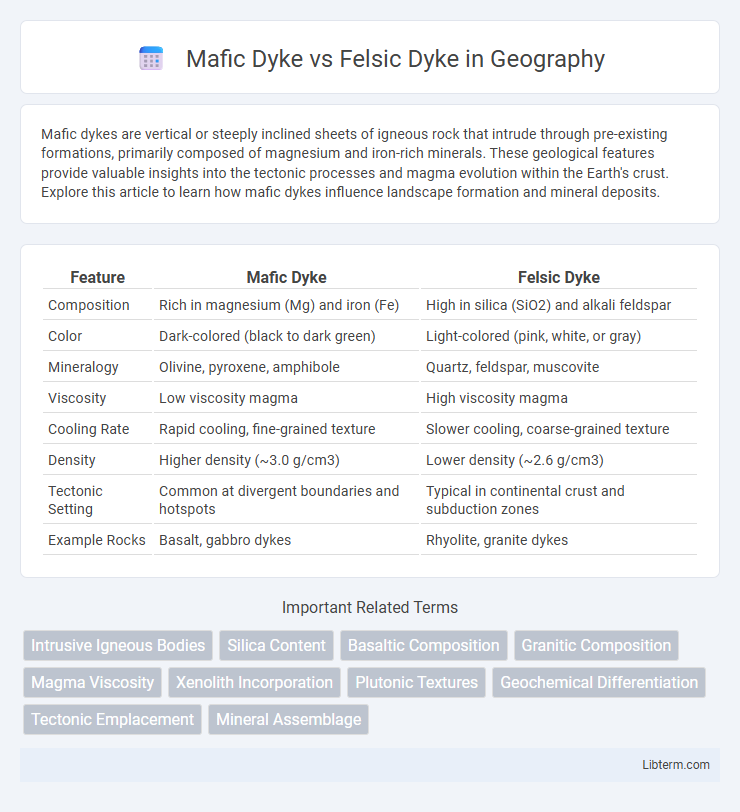Mafic dykes are vertical or steeply inclined sheets of igneous rock that intrude through pre-existing formations, primarily composed of magnesium and iron-rich minerals. These geological features provide valuable insights into the tectonic processes and magma evolution within the Earth's crust. Explore this article to learn how mafic dykes influence landscape formation and mineral deposits.
Table of Comparison
| Feature | Mafic Dyke | Felsic Dyke |
|---|---|---|
| Composition | Rich in magnesium (Mg) and iron (Fe) | High in silica (SiO2) and alkali feldspar |
| Color | Dark-colored (black to dark green) | Light-colored (pink, white, or gray) |
| Mineralogy | Olivine, pyroxene, amphibole | Quartz, feldspar, muscovite |
| Viscosity | Low viscosity magma | High viscosity magma |
| Cooling Rate | Rapid cooling, fine-grained texture | Slower cooling, coarse-grained texture |
| Density | Higher density (~3.0 g/cm3) | Lower density (~2.6 g/cm3) |
| Tectonic Setting | Common at divergent boundaries and hotspots | Typical in continental crust and subduction zones |
| Example Rocks | Basalt, gabbro dykes | Rhyolite, granite dykes |
Introduction to Mafic and Felsic Dykes
Mafic dykes are intrusive igneous rock formations rich in magnesium and iron, typically composed of minerals like pyroxene and olivine, giving them a darker color and higher density. Felsic dykes contain a higher concentration of silica and lighter minerals such as quartz and feldspar, resulting in a lighter color and lower density. These contrasting mineralogies influence their formation environments and geochemical properties, distinguishing mafic dykes from felsic dykes in geological studies.
Defining Mafic Dyke: Composition and Characteristics
A mafic dyke is a sheet-like intrusion of igneous rock characterized by high magnesium and iron content, predominantly composed of minerals such as pyroxene and olivine. These dykes exhibit a dark color and higher density compared to felsic dykes, which are richer in silica and lighter minerals like quartz and feldspar. Mafic dykes typically form from basaltic magma and are associated with tectonic activities such as rifting and seafloor spreading.
Felsic Dyke: Mineralogy and Distinct Features
Felsic dykes are primarily composed of quartz, feldspar, and mica, exhibiting a light color and high silica content typically above 65%. Their mineralogy contrasts sharply with mafic dykes, which contain abundant pyroxene and olivine, and lower silica content generally below 52%. Felsic dykes often feature coarse-grained textures and are associated with continental crust environments, reflecting their rich aluminum and potassium content.
Geochemical Differences Between Mafic and Felsic Dykes
Mafic dykes are rich in iron (Fe), magnesium (Mg), calcium (Ca), and have higher concentrations of mafic minerals like pyroxene and olivine, resulting in lower silica (SiO2) content typically below 52%. Felsic dykes exhibit elevated levels of silica (SiO2 over 66%), sodium (Na), and potassium (K), with abundant quartz and feldspar minerals, reflecting a more evolved geochemical signature. Trace element analysis shows mafic dykes enriched in compatible elements such as Ni, Cr, and Co, while felsic dykes have higher incompatible element concentrations like Rb, Ba, and Sr, highlighting contrasting magma sources and crystallization histories.
Formation Processes of Mafic vs Felsic Dykes
Mafic dykes form when magnesium- and iron-rich magma from the mantle intrudes cracks in the crust, rapidly cooling to create dark, dense rock dominated by pyroxene and olivine. Felsic dykes originate from silica-rich magma derived from the partial melting of continental crust, crystallizing into light-colored, quartz- and feldspar-dominated compositions. The contrasting formation processes involve differences in magma source, temperature, viscosity, and crystallization rates, controlling the mineralogy and texture of mafic versus felsic dykes.
Textural Variations: Mafic vs Felsic Intrusions
Mafic dykes exhibit a coarse-grained, often porphyritic texture with abundant pyroxene and olivine phenocrysts embedded in a fine-grained matrix, indicating rapid cooling of basaltic magma. Felsic dykes show a finer-grained, holocrystalline texture dominated by quartz, feldspar, and mica minerals, reflecting slower crystallization of silicic magma. Textural differences between mafic and felsic intrusions result from variations in magma composition, cooling rates, and emplacement depth, influencing crystal size and mineral assemblages.
Field Identification: Key Visual Markers
Mafic dykes typically appear dark-colored, often black or greenish, due to their high content of iron and magnesium-rich minerals such as pyroxene and olivine, and present a fine- to medium-grained texture in the field. Felsic dykes are lighter in color, usually white, pink, or light gray, reflecting their composition of quartz, feldspar, and mica, with a generally coarse-grained or porphyritic texture. Key visual markers include mafic dykes' dense, dark appearance and their tendency to chill against surrounding rocks, while felsic dykes show lighter hues and may host visible phenocrysts or flow structures.
Geological Significance and Associated Rock Types
Mafic dykes primarily consist of pyroxene and plagioclase, reflecting a mantle-derived mafic magma that intrudes crustal rocks, often linked with basalt and gabbro formations. Felsic dykes are rich in quartz and feldspar, indicating a silica-rich, crustal magma source associated with granitic and rhyolitic rock types. Both dyke types provide crucial insights into magma differentiation, tectonic settings, and crust-mantle interactions during igneous processes.
Economic Importance and Resource Potential
Mafic dykes, rich in magnesium and iron, often host valuable minerals such as chromium, nickel, and platinum-group elements, making them significant targets for mining and industrial use. Felsic dykes, characterized by high silica content, are less commonly associated with metallic ore deposits but can indicate the presence of rare earth elements and gemstones important for high-tech applications. Both mafic and felsic dykes contribute to understanding regional magmatic processes, aiding exploration strategies for economically viable mineral resources.
Summary: Comparing Mafic and Felsic Dykes
Mafic dykes are igneous intrusions composed primarily of magnesium and iron-rich minerals, exhibiting dark coloration and a fine-grained texture. Felsic dykes contain high silica content with light-colored minerals such as quartz and feldspar, resulting in a coarser texture and lower density. The contrast in mineralogy and chemical composition between mafic and felsic dykes reflects their formation from different magma sources and influences their physical and geochemical properties.
Mafic Dyke Infographic

 libterm.com
libterm.com